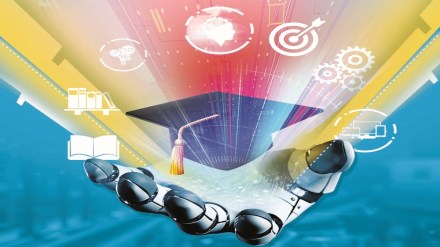Artificial intelligence has quietly moved from being a assignment helper to becoming a full-fledged study partner, guiding students step by step. Across classrooms, and living rooms, a new generation of AI-powered tutoring tools are aiming not just to give answers, but to transform how young people learn, and the shift is accelerating.
The latest example comes from OpenAI, which has rolled out Study Mode inside ChatGPT to users worldwide on Free, Plus, Pro, and Team plans. Available across iOS, Android, web, and desktop, the feature turns the chatbot into an adaptive learning environment. When a student activates Study Mode, ChatGPT begins by asking questions to gauge their goals and skill level. From there, it builds a personalised learning path, breaking complex ideas into manageable sections, using prompts to develop reasoning, and adding complexity only as the learner is ready. “Instead of doing the work for them, study mode encourages students to think critically about their learning. Features like these are a positive step toward effective AI use for learning,” said Robbie Torney, senior director of AI Programs at Common Sense Media. If the user has chat memory turned on, responses can draw on prior conversations to offer examples and tips tailored to their style. Students can upload course materials, from PDFs to images, and have the AI work with those directly. The feature even checks comprehension through open-ended prompts and targeted feedback.
In India and many other countries, quality after-school help can be expensive and uneven in quality. AI tools, as per OpenAI creators, can offer consistent, round-the-clock guidance at a fraction of the cost.
The wider AI tutoring wave
OpenAI is hardly alone in this push. In Chennai, education technology company Evo11ve.AI has launched its “Evo11ve AI Coach”, an online portal aimed at students from classes 6 to 12 under the CBSE curriculum. During the launch, founder and CEO Swapna Reddy said the tool is designed to identify knowledge gaps and offer personalised strategies to close them, with the goal of boosting student performance by 10-20 percentage points through sustained use. “We strongly believe that with the right learning strategies and
personalisation, children can learn anything,” she said. Citing a study which found that only 43% of children aged 14 to 18 can solve a three-digit division problem and just 57.3% can read English sentences, Reddy said that such issues can be addressed effectively with the right use of AI. Khanmigo, by edutech giant Khan Academy, also has an AI-powered personal tutor embedded within its vast library of content. Covering math, humanities, coding, social studies and more, Khanmigo offers real-time tutoring tied to specific exercises, videos, and articles. Unlike some AI tools, it does not simply give correct answers; instead, it guides learners patiently toward finding them on their own, with safety and pedagogy at its core.
According to OpenAI’s own user data, more than one-third of Americans aged 18-24 use ChatGPT, and over a quarter of their messages are related to schoolwork, tutoring, or learning. In a survey of college-aged users, 3 in 4 said they want AI incorporated into their education. Part of the appeal is pace and adaptability. Traditional classroom teaching works to a set curriculum and schedule. AI tutors can be summoned at any hour, repeat explanations endlessly, and adjusted to a student’s strengths and weaknesses. According to one Harvard Gazette study, led by lecturers Gregory Kestin and Kelly Miller, AI tutoring not only helped students cover more material, but also boosted self-reported motivation and engagement. Students said they felt more willing to tackle difficult concepts when an AI tutor could guide them through the struggle rather than simply hand over the solution.
Note of caution
Still, Kestin and Miller are quick to note the risks. “While AI has the potential to supercharge learning, it could also undermine learning if we’re not careful,” Kestin cautioned. “AI tutors shouldn’t ‘think’ for students, but rather help them build critical thinking skills. AI tutors shouldn’t replace in-person instruction, but help all students better prepare for it, and possibly in a more engaging way than ever before.”
In a recent study from Massachusetts Institute of Technology, researchers showed how the use of AI impacts learning and how convenience could come at a cost. The study looked at essay writing across three groups, people using a language learning model (ChatGPT), a search engine, or just their own brain power. It stated that brain connectivity systematically scaled down with the amount of external support: the brain-only group exhibited the strongest, widest-ranging networks, search engine group showed intermediate engagement, and ChatGPT assistance elicited the weakest overall coupling.
Not just the weakening cognitive abilities, but there is a connection to dark triad as well. Another study published in BMC Psychology showed a link between the use of AI tools among students and their behavioural patterns. A group of South Korean researchers found that the students who scored higher on traits, such as narcissism, psychopathy, and Machiavellianism, were much more likely to use AI tools to get their assignments done. Educators and technologists agree that the balance lies in design and usage. AI tutors work best when they function as coaches, not crutches, prompting the student to work through a problem. Tools like Study Mode and Khanmigo explicitly adopt this approach, echoing long-standing pedagogical methods. The question is not about whether students will use AI to learn anymore. It is how to make AI become a standard part of lesson planning? Or will schools and colleges draw hard boundaries to prevent over-reliance? The uptake is strong, and the models are evolving fast. Early results suggest that AI tutors could be here to stay, as long as they complement, rather than replace, the human touch in education.
